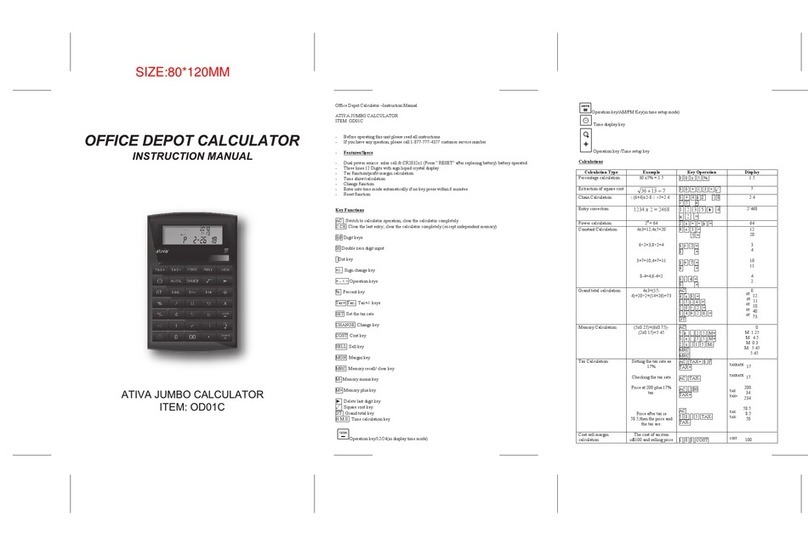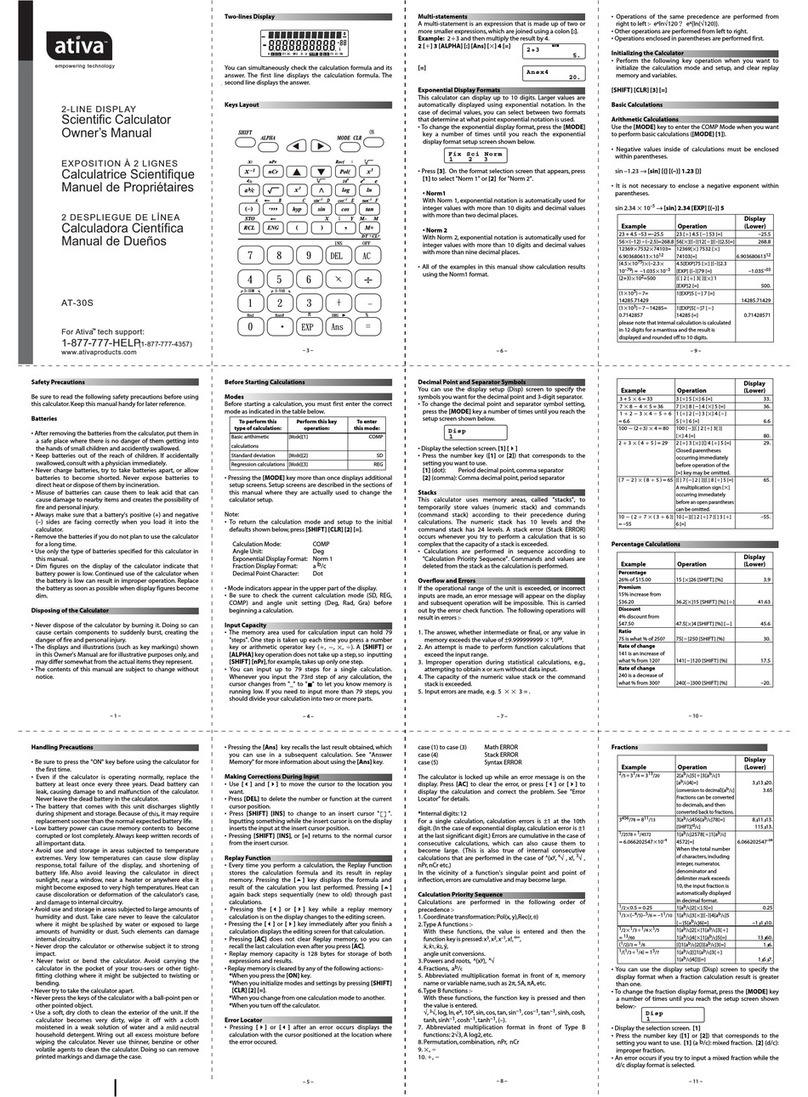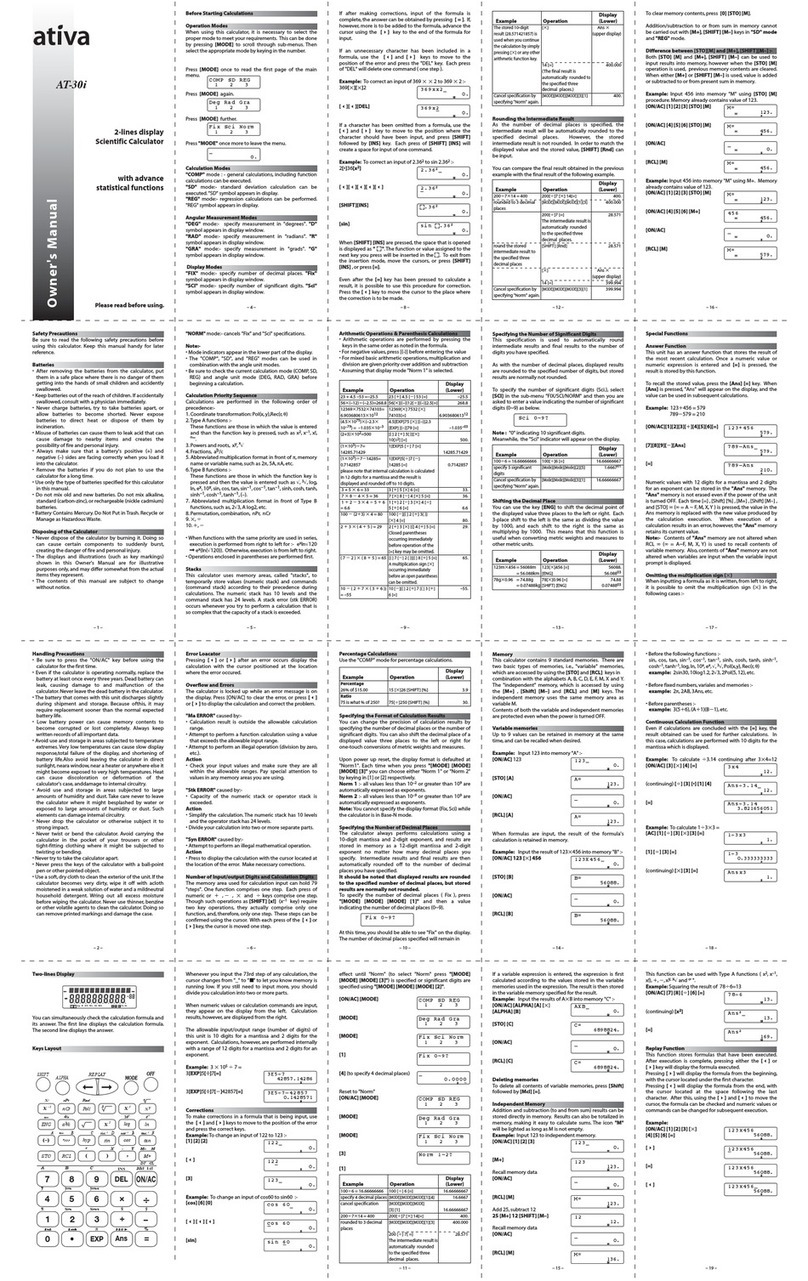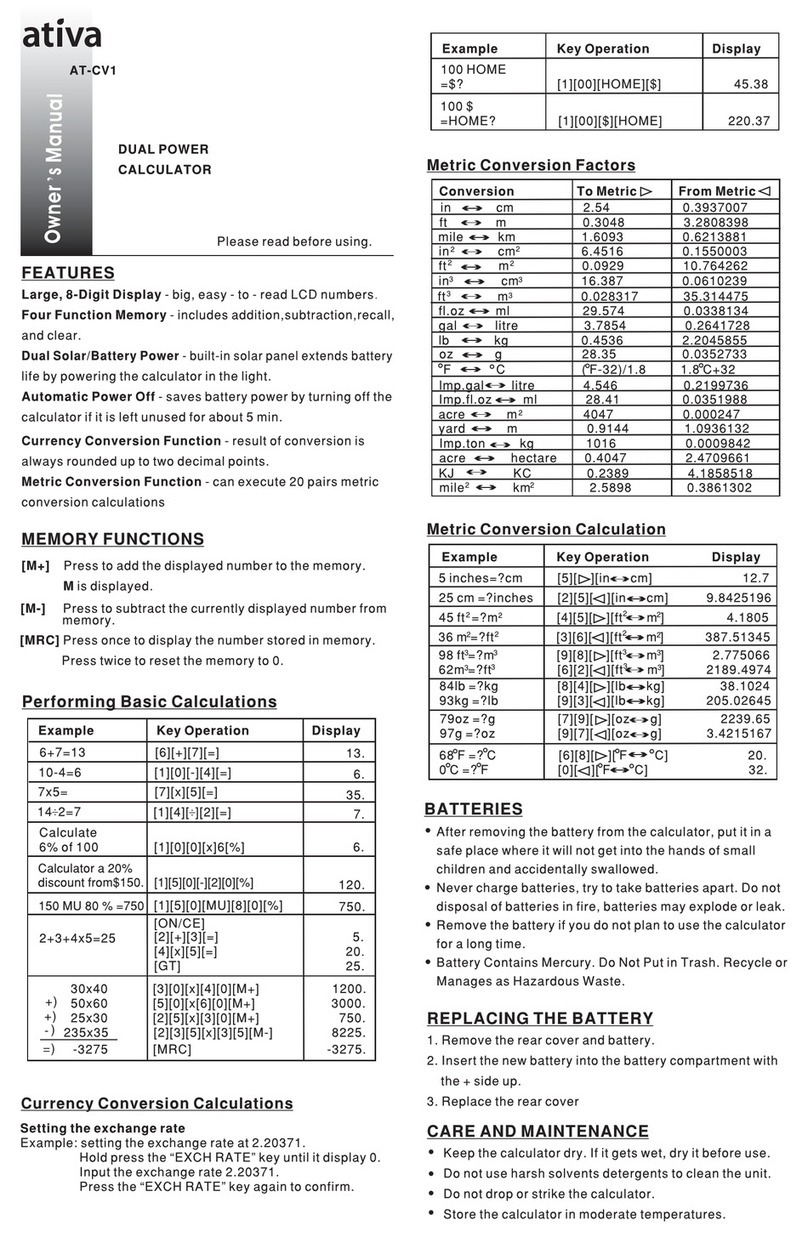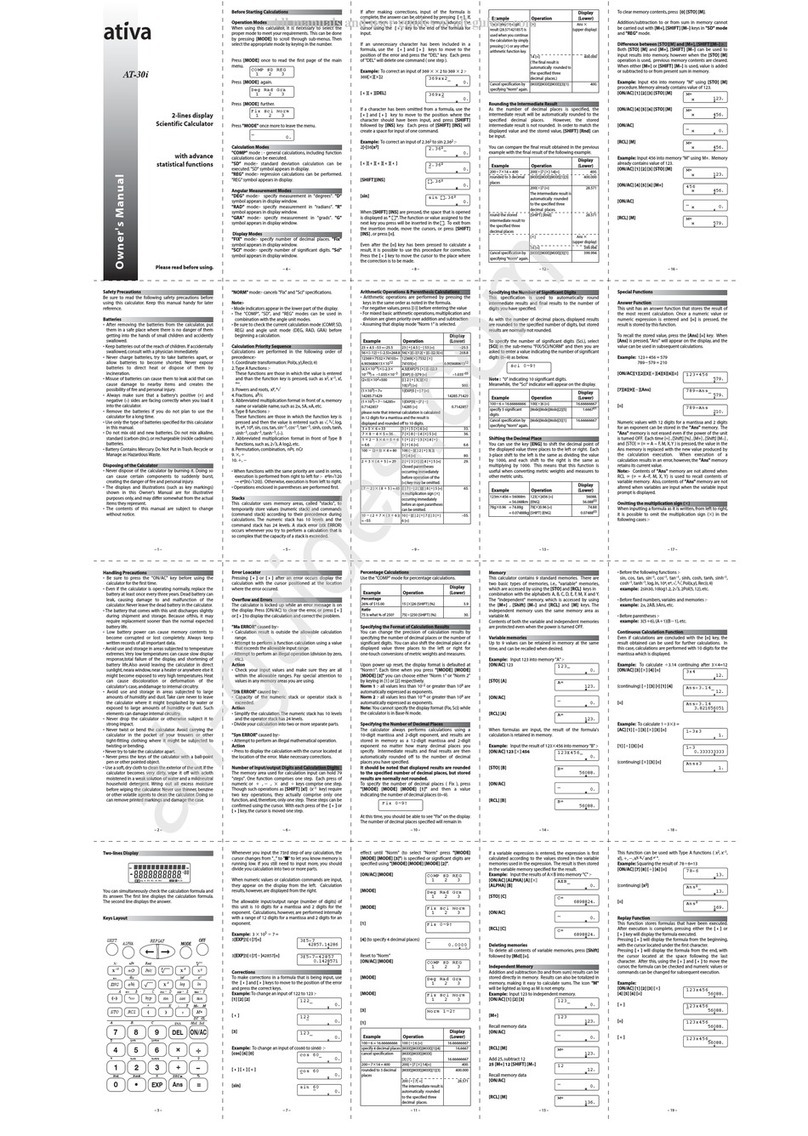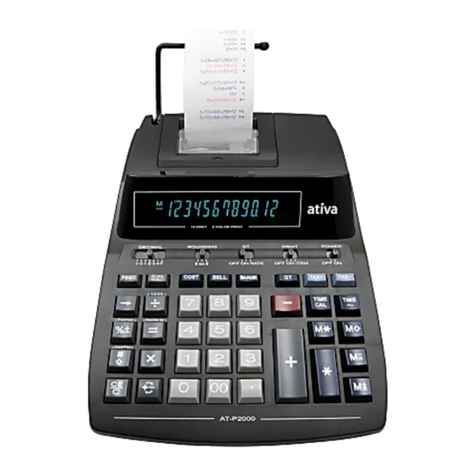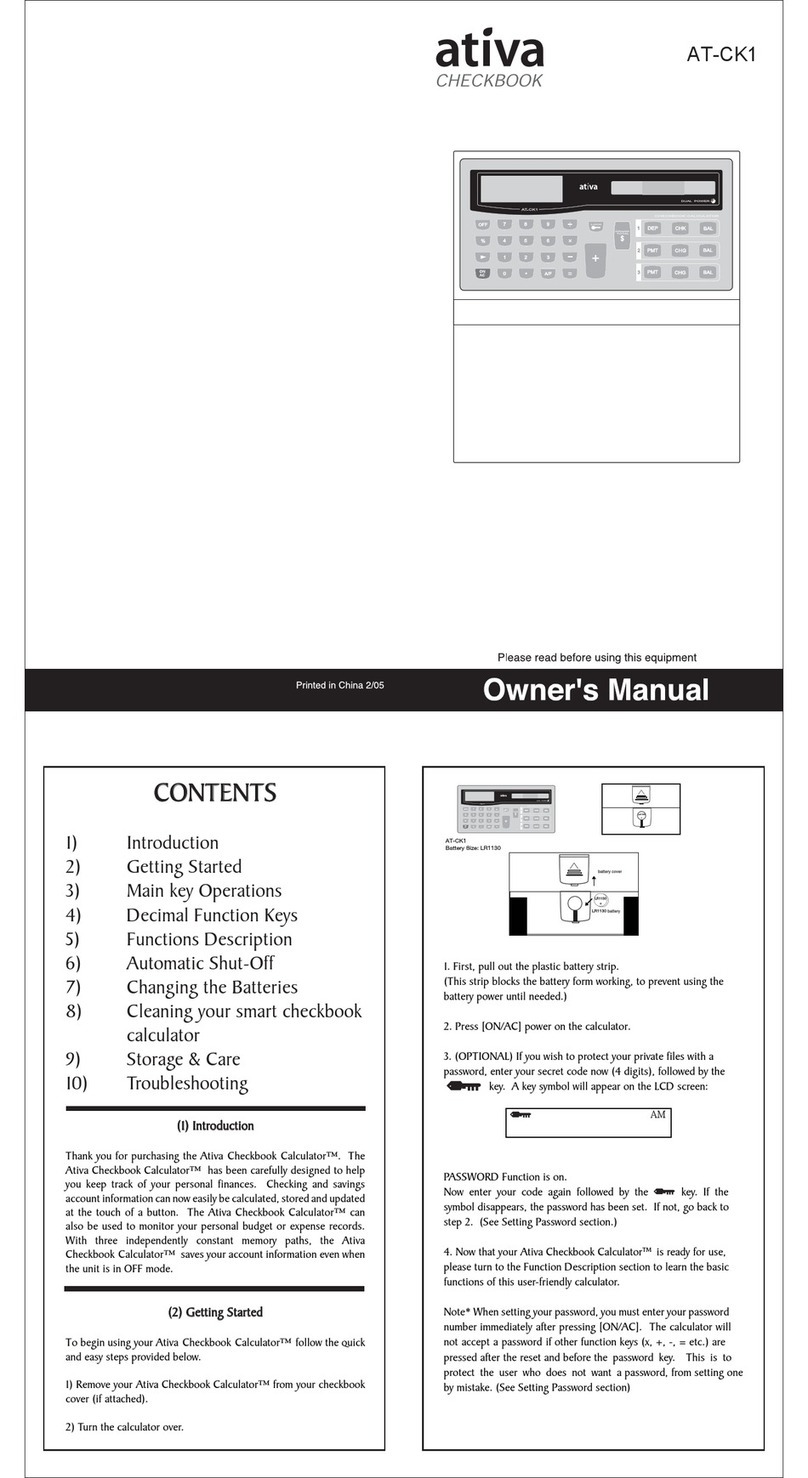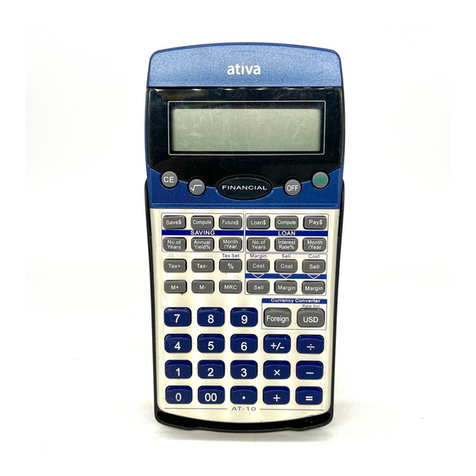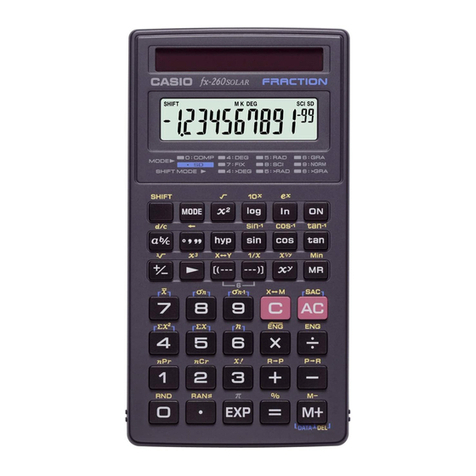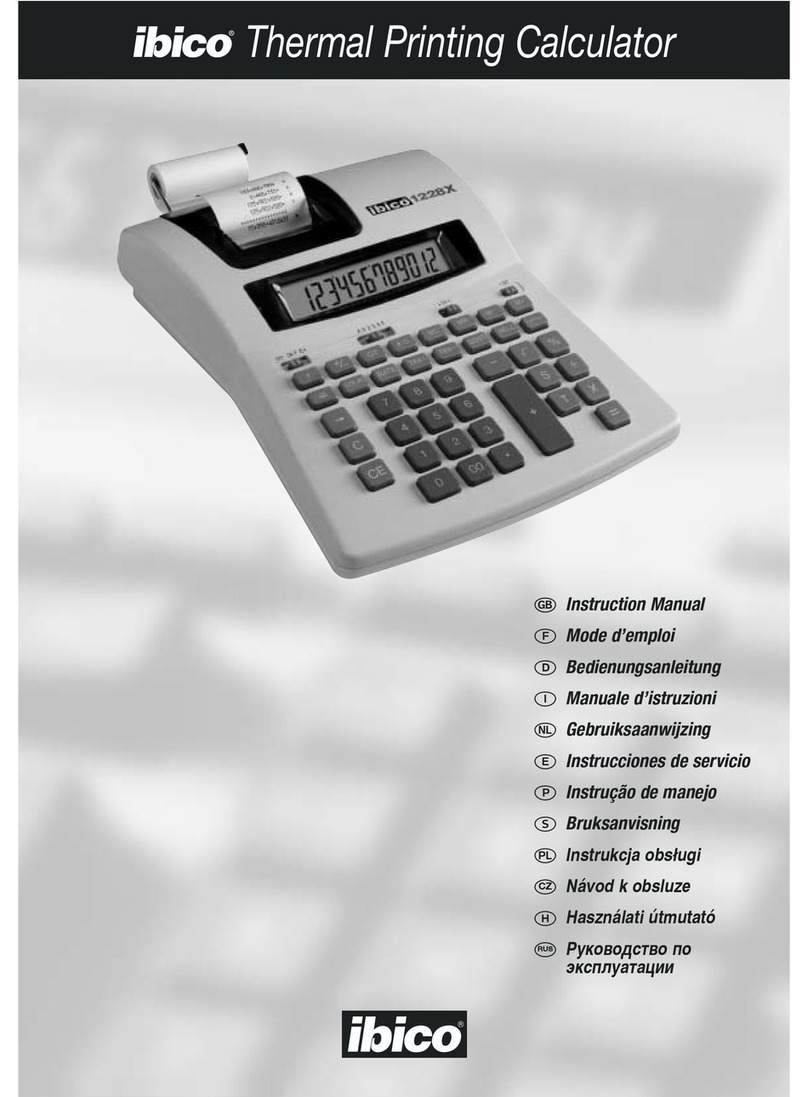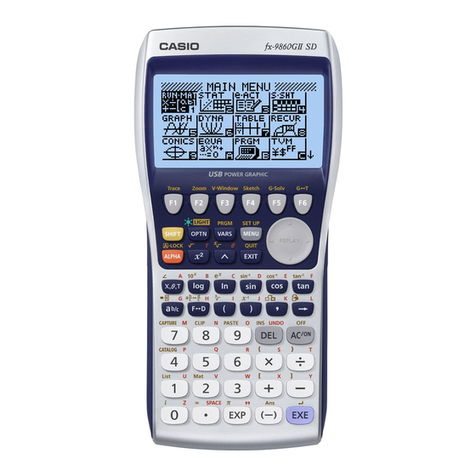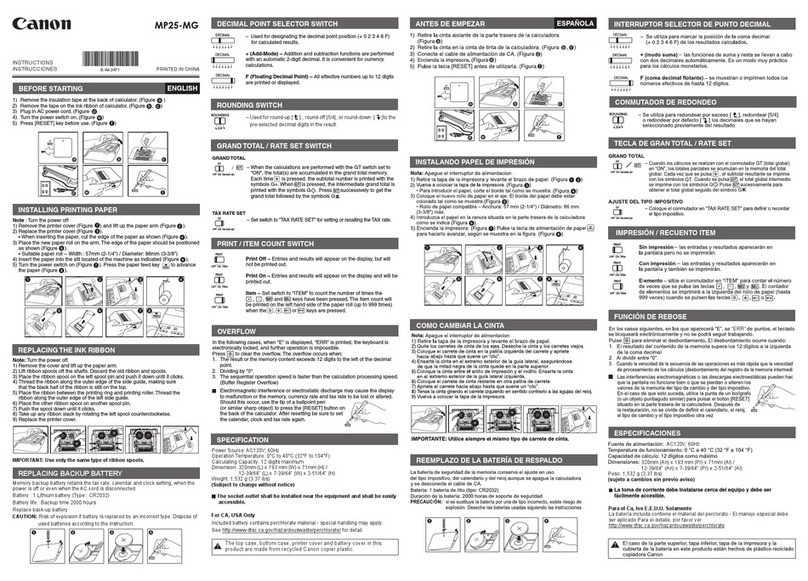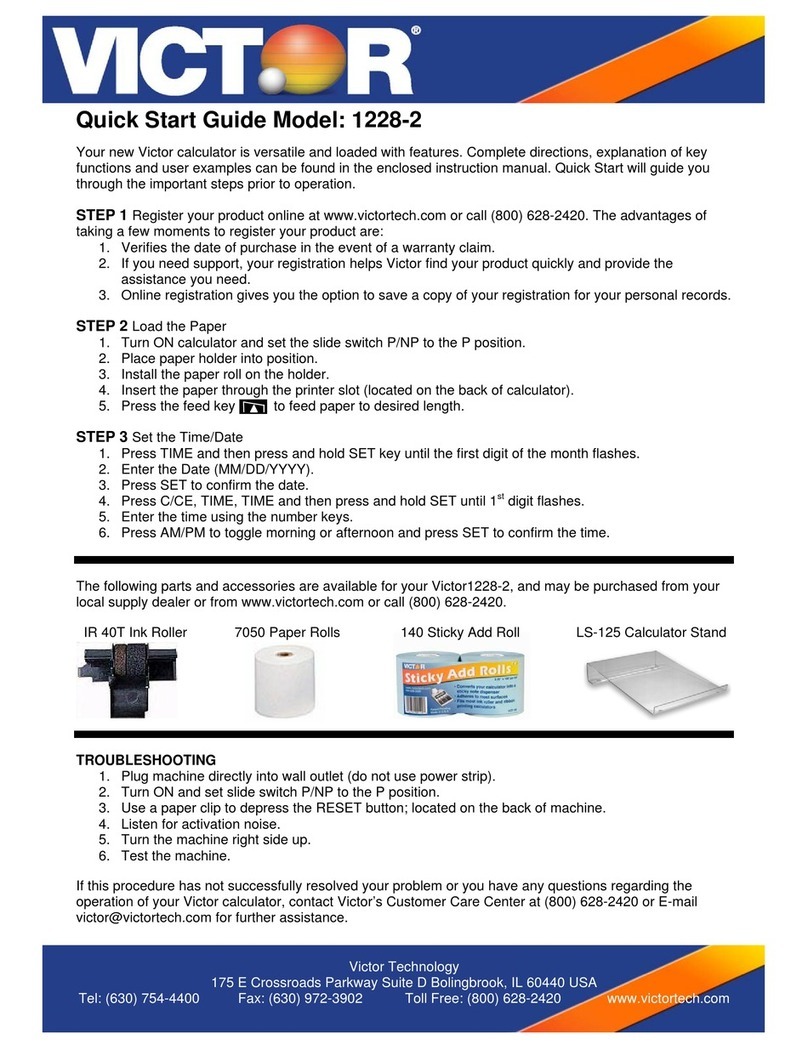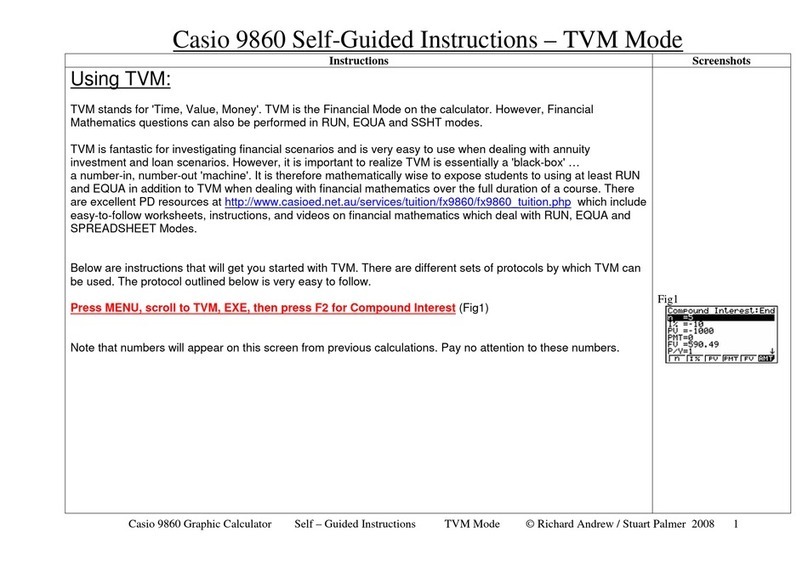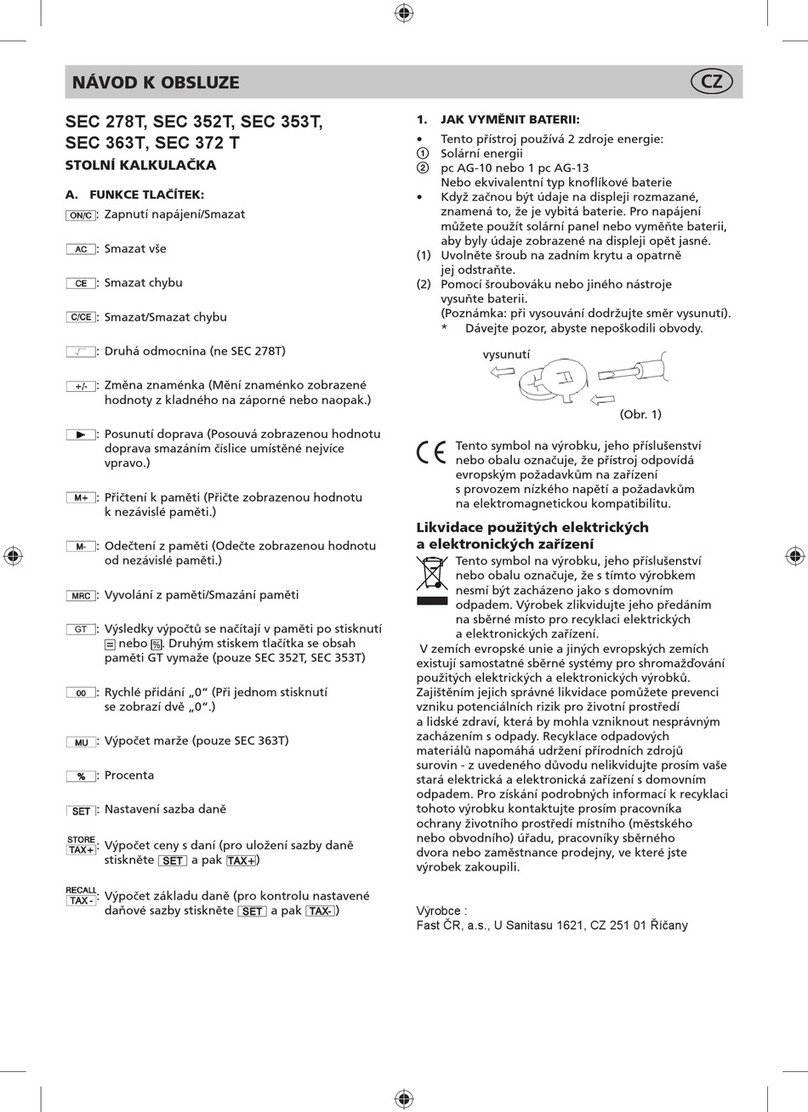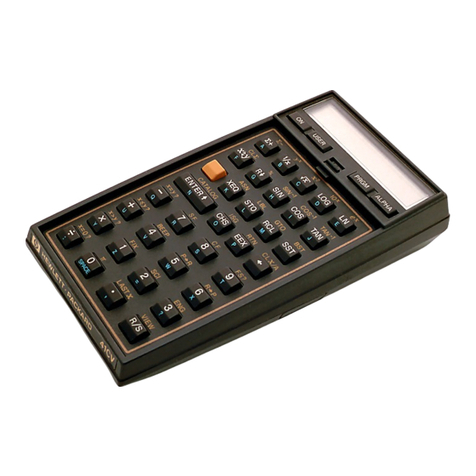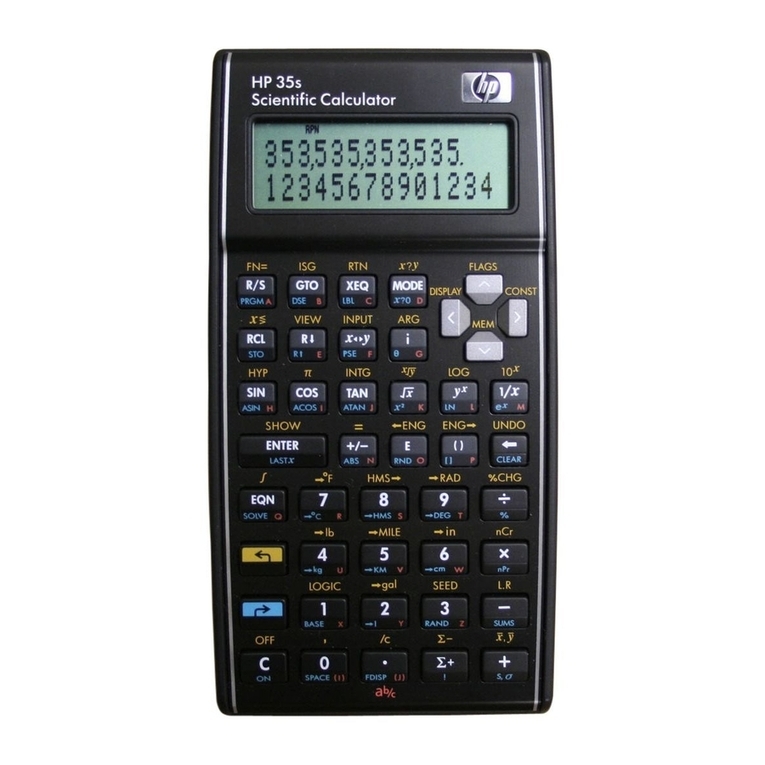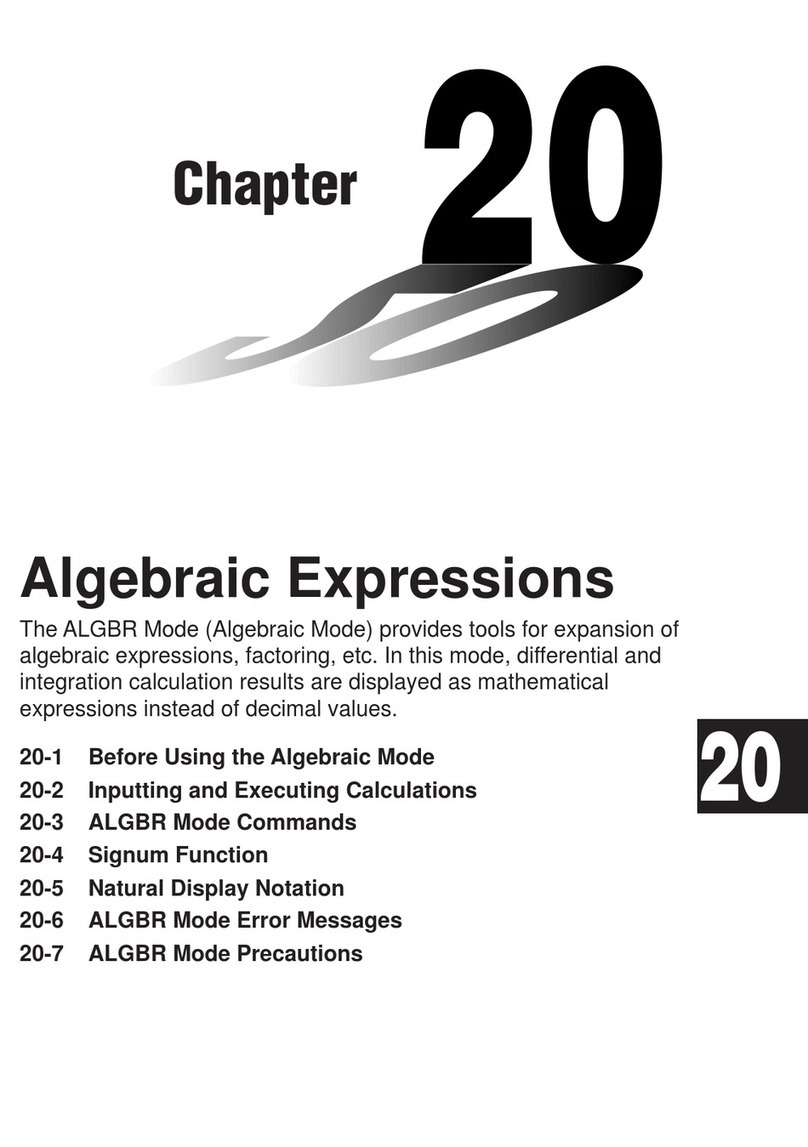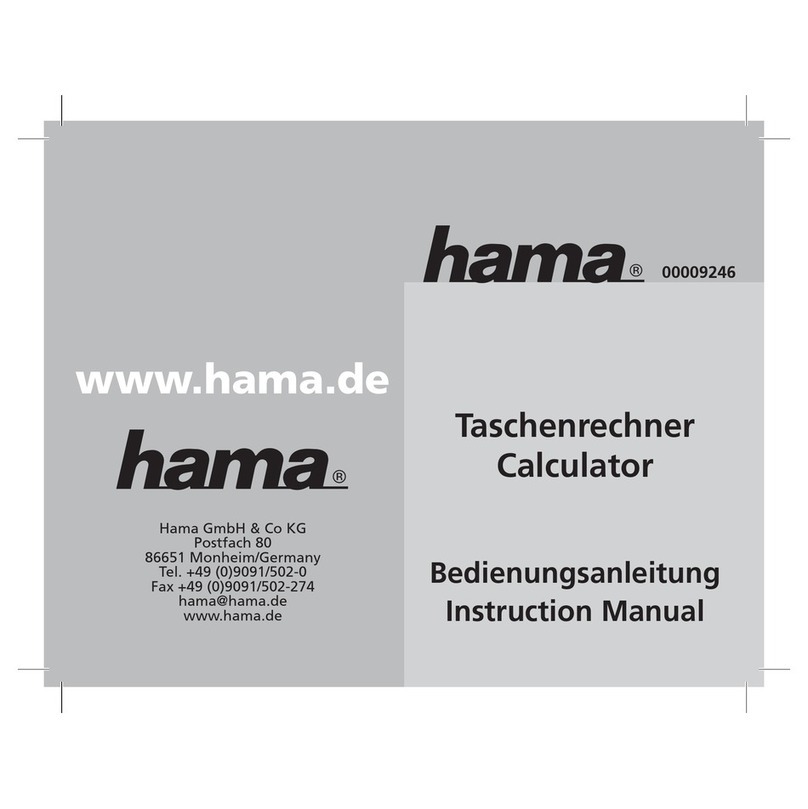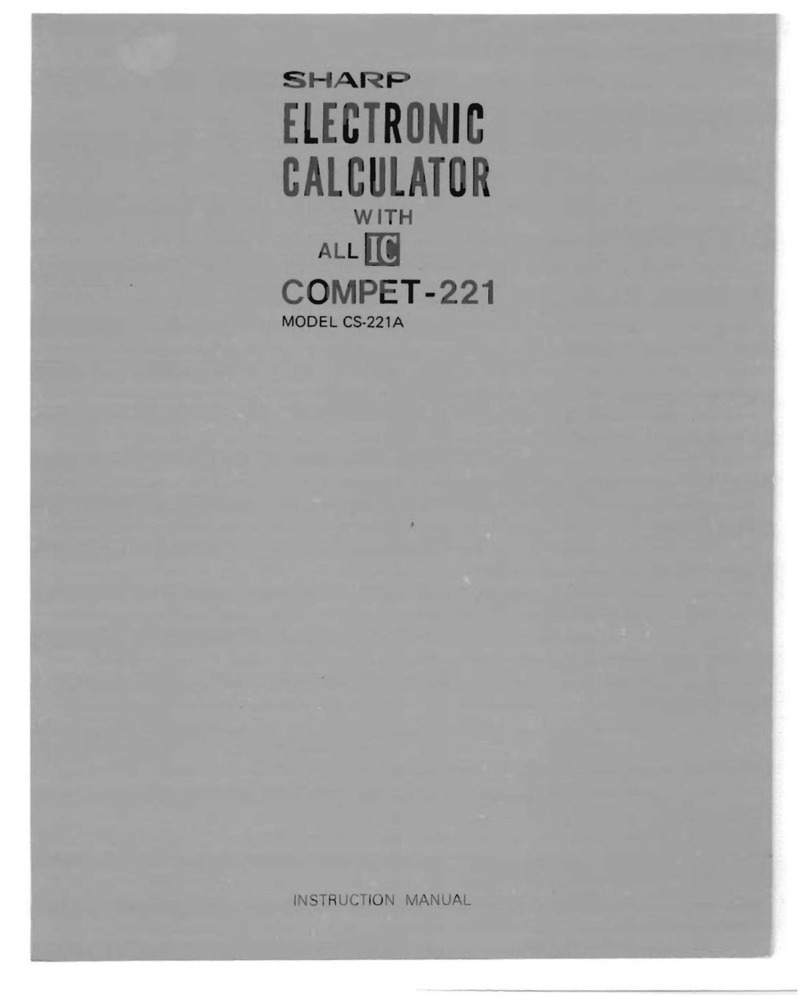Ativa AT-36 User manual

GeneralGuide
nTurnin g o n oroff
Toturnthe calculatoron,press [ON];Toturnthe calculatoroff,
press [2nd ][OFF ].
nBatteryreplacement
AT-36 isdualpowersystemwhichispowered byone alkaline bat-
tery(GP76A)and asolarcell.If the displaybecomesdimand difficult
toread (especiallywhen lighting isdim),the batteriesshouldbe
replaced assoon aspossible.
Toreplacebatteries:
1)Removethe screwsand the back cover.
2)Replacethe oldbatteriesand install newoneswithpolarity
incorrectdirections,then securethe screwsinplaceand
press [ON]toturnthe poweron.
nAutop o wer-off function
Thiscalculatorautomaticallyturnsitoff when notoperated forap-
proximately9~15 minutes.It can be reactivated bypressing [ON]
keyand the display,memory,settingsareretained.
nResetop eratio n
If the calculatorison butyou getunexpected results,press [2nd ]
[RESET]insequence.Amessage appearson the displaytoconfirm
whetheryou wanttoresetthe calculatorand clearmemorycontents.
RESET:NY
Movethe cursorto“Y”by[4], then press []toclearall variables,
programs,pending operations,statisticaldata,answers,all previ-
ousentries,and memory;Toabortthe resetoperation withoutclear-
ing the calculator,pleasechoose“N”.
If the calculatorislock and furtherkeyoperationsbecomes
impossible,pleasepress [0][DMS]atthe sametimetoreleasethe
condition.It will returnall settingstodefaultsettings.
nCo n trastadjustment
Pressing the [6]or[5]following [MODE]keycan makethe con-
trastofthe screen lighterordarker.Holding eitherkeydownwill
makethe displaybecomerespectivelylighterordarker.
nDisplay readout
The displaycomprisesthe entryline,the resultline,and indicators.
EntrylineAT-36 displays an entryofup to76 digits.Entriesbe-
ginon the left ;thosewithmorethan 11 digitsscroll to
the left. Press [4]or[3]tomovethe cursorthrough an
entry.Press [2nd ][3]or[2nd ][4]tomovethe cursor
immediatelytothe beginning orend ofthe entry.
ResultlineIt displays aresultofup to10 digits,aswell asadecimal,
anegativesign,a“x10 ”indicator,and a2-digitsposi-
tiveornegativeexponent. Resultsthatexceed the digit
limitaredisplayed inscientificnotation.
IndicatorsThe following indicatorsappearon the displaytoindi-
cateyou the currentstatusofthe calculator.
IndicatorMeanin g
MIndependentmemory
–Resultisnegative
2nd 2nd setoffunction keys isactive.
MODEMode selection isactive
MAINMainmode isactive
STATStatistics mode isactive
Base-nBase-nmode isactive
VLEVariablelinearequation mode isactive
QEQuadraticequation mode isactive
CPLXComplexnumbermode isactive
DEGRAD Anglemode :DEGrees,GRADs,orRADs
ENGSCIENGineering orSCIentificnotation.
TAB Numberofdecimalplacesdisplayed isfixed
HYP Hyperbolic-trigfunction will be calculated
BUSY Whilean operation isexecuting
ç è Therearedigitstothe left orrightofthe display
é êThereareearlierorlaterresultsthatcan be
displayed
Beforestarting calculation
nChanging amo d e
Pressing [MODE]can entermode menus.You can chooseone of
sixoperating modes,including “0)MAIN”,“1)STAT”,“2)Base-
n”,“3)CPLX”,“4)VLE”,“5)QE”.
Give“2)Base-n”asan example:
Method 1:Scroll through the menususing [3]or[4]until
“2)Base-n”isshown,then enterthe desired mode
bypressing [].
Method 2:Keyindirectlythe numberofthe mode,[2],toenterthe
desired mode immediately.
nSele c ting anitemfromdispla y men u s
Manyfunctionsand settingsareavailableon menus.Amenu isalist
ofoptionsdisplayed across the entryline.
Give“Pressing [DRG]keydisplays the menu forchoosing the
anglesetting underMAINmode ”asan example:
Method :Press [DRG]todisplaythe menu,and then movethe
cursor[3]or[4]toan itemyou want. Press []while
the itemisunderlined.
Formenu itemsfollowed byan argumentvalue,you can press
[]whilethe itemisunderlined orenterdirectlythe correspond-
ing argumentvalue.
nUsing “2n d ”k ey s
Toexecutethe functionsmarked inyellow,pleasepress [2nd ]and
then the corresponding key.When you press [2nd ], the “2nd ”indi-
catorshowninthe displayistotell you thatyou will be selecting the
second function ofthe nextkeyyou press.If you press [2nd ]by
mistake,simplypress [2nd ]againtoremovethe “2nd ”indicator.
nCursor
Pressing [3]or[4]keycan movethe cursortothe left orthe right.
Holddownanyofthosekeys tomovethe cursorathigh speed.
Pressing [5]or[6]can scroll the displayup ordownwhilethere
arepreviousentrieshidden the display.You can reuseoredita
previousentrywhen itison the entryline.
nMa k in g corr ectio n sd uring input
Todeleteacharacteratthe cursor,makethe characterunderlined
byusing [3]or[4]tomovethe cursor,and then press [DEL]to
deletethe character.
Toreplaceacharacter,makethe characterunderlined byusing [3]
or[4]tomovethe cursor,and then enteranewentrytoreplacethe
character.
Toinsertacharacter,movethe cursortothe position ofthe charac-
terwhereyou wanttoinsert, itwill be inserted inthe frontofthe
characterafterpressing [2nd ][INS]and entering anewcharacter.
(Note):The blinking cursor“3”meansthe calculatorisininsert
mode Onthe contrary,the blinking cursorisdisplayed as
“_”and itmeansthe calculatorisinoverwritemode.
Toclearall characters,clearall inputcharacterby[CL]key.
nReplay functio n
•Thisfunction storesthe latestoperation executed.Afterexecution
iscompleted,pressing [6]or[5]keywill displaythe operation
fromthe beginning orthe end.You can continuemoving the cursor
by[4]or[3]toeditit. Todeleteadigit, press [DEL]. (or,in
overwritemode,justtype overthe digit).See Example1.
•The replayfunction can keep inputdigitsup to254 charactersfor
AT-36.Afterexecution iscompleted orduring entering,you can
press either[5]or[6]todisplaypreviousinputstepsand edit
valuesorcommandsforsubsequentexecution.See Example2.
(Note):The replayfunctionisn’tcleared even when [CL]ispressed
orpoweristurned off, socontentscan be recalled even
after[CL]ispressed.However,replayfunction iscleared
when mode isswitched.
nErrorposition displa y function
•When amathematicallyillegalcalculation isperformed,errorpo-
sition displayfunction will tell you withthe cursorwherethe error
is.Press [4]or[3]tomovethe cursorand then giveitacorrect
entry.You can alsoclearan errorbypressing [CL]and then re-
entered the valuesand expression fromthe beginning.See Ex-
ample3.
nMemoryc a lculation
•Press [M+]toadd aresulttorunning memory.Press [2nd ]
[M–]tosubtractthe value fromrunning memory.Torecall the
value inrunning memory,press [MRC ]. Toclearrunning memory,
press [MRC ]twice.See Example4.
•The calculatorhasten memoryvariablesforrepeated use:A,B,C,
X,Y,M,X1,X2,
PROG1
and
PROG2
.You can storearealnumberin
variablesA,B,C,X,Y,M,X1,X2and twoexpressionsin
PROG1
and
PROG2
.See Example5.
*[P/VRCL]recallsall variables.
*[SAVE ]letsyou storevaluestovariables.
*[2nd ][RECALL ]recallsthe value ofvariable.
*[2nd ][CL-VAR]clearsall variablesexcept
PROG1,PROG2
.
*[2nd ][CL-PROG ]clearsthe contentsof
PROG1,PROG2
.
(Note):Besidespressing [SAVE ]keytostoreavalue,you can
alsoassign valuestomemoryvariableMby[M+]or
[2nd ][M–]. However,anything currentlystored invari-
ableMwill be deleted and replaced itwiththe newlyas-
signedvalue.
nOrderofo p eration s
Eachcalculation isperformed inthe following orderofprecedence
:
1)Expression inside parentheses.
2)Coordinatestransformation,and Type Bfunctionswhichare
required pressing the function keybeforeentering,for
example,sin,cos,tan,sin–1,cos–1,tan –1,sinh,cosh,tanh,
sinh –1,cosh–1,tanh –1,log,ln,10 X,eX,,NEG,NOT,X
’(),Y’().
3)Type Afunctionswhicharerequired entering valuesbefore
pressing the function key,forexample,x2,°′′′,!, x–1,%,r,
g.
4)Exponentiation (∧),x
5)Fractions
6)Abbreviated multiplication formatinfrontofvariables,π,
RANDM,RANDMI.
7) ( –)
8)Abbreviated multiplication formatinfrontofType Bfunctions
,Alog2,etc.
9)nPr,nCr
10)x,
11)+,–
12)AND,NAND
13)OR,XOR,XNOR
14)Conversion (Ab/c
34
d/e,F
34
D,4DMS)
•When functionswiththe samepriorityareused inseries,
execution isperformed fromrighttoleft.
eXln120→eX{ln(120 )}
otherwise,execution isfromleft toright.
•Compound functionsareexecuted fromrighttoleft.
•Anything contained withinparenthesesreceivesthe high-
estpriority.
nAccuracy an d Capac ity
Outputdigits:Upto10 digits.
Calculating digits:Upto24 digits
Ingeneral,everyreasonablecalculation isdisplayed up to10 digits
mantissa,or10-digitsmantissaplus2-digitsexponentup to10 ±99.
Numbersused asinputmustbe withinthe range ofthe given function
asfollow:
FunctionsInputrange
sinx,cosx,tanxDeg:|x|<4.5x10 10 deg
Rad:|x|<2.5x10 8πrad
Grad:|x|<5x10 10 grad
however,fortan x
Deg:|x|≠90 (2n+1)
Rad:|x|≠(2n+1)
Grad:|x|≠100 (2n+1)(nisan integer)
sin-1x,cos-1x | x|≤1
tan -1x | x|<1x10 100
sinh x,coshx | x|≤230.2585092
tanhx | x|<1x10 100
sinh -1x | x|<5x10 99
cosh-1x1≤x<5x10 99
tanh -1x | x|<1
log x,lnx1x10 -99 ≤x<1x10 100
10 x-1x10 100 <x<100
ex-1x10 100 <x≤230.2585092
0≤x<1x10 100
x2|x|<1x10 50
x–1|x|<1x10 100,X≠0
x!0≤x≤69 ,xisan integer.
P(x,y)22 yx +<1x10 100
R(r,θ)0≤r<1x10 100
Deg:|θ|<4.5x10 10 deg
Rad:|θ|<2.5x10 8πrad
Grad:|θ|<5x10 10 grad,however,fortan x
Deg:|θ|≠90 (2n+1)
Rad:|θ|≠(2n+1)
Grad:|θ|≠100 (2n+1)(nisan integer)
4DMS|DD |,MM,SS.SS <1x10 100,
0≤MM,SS.SS ,|x|< 10 100
xyx>0:–1x10 100 <ylog x<100
x=0:y>0
x<0:y=n,1/(2n+1),nisan integer.
but-1x10 100 <log |x|<100
y>0:x≠0,–1x10 100 <log y<100
y=0:x>0
y<0:x=2n+1,I/n,nisan integer.(n≠0)
but–1x10 100 <log |y|<100
nPr,nCr0≤r≤n,n<10 100,n,rareintegers.
STAT|x|<1x10 100,|y|<1x10 100
1-VAR:n≤40,2-VAR:n≤40
FREQ.=n,0≤n<10100 :nisan integerin1-
VARmode.
_ _
σx,σy,x,y,a,b,r:n≠0
Sx,Sy:n≠0,1
Base-nDEC:–2147483648 ≤x≤2147483647
BIN:
10000000000000000000000000000000
≤x≤1111111111111111111111111111111111
(fornegative)
0≤x≤0111111111111111111111111111111111
(forzero,positive)
OCT:
20000000000 ≤x≤37777777777
(fornegative)
0≤x≤17777777777 (forzeroorpositive)
HEX :
80000000 ≤x≤FFFFFFFF(fornegative)
0≤x≤7FFFFFFF (forzeroorpositive)
nEr r orconditions
Errormessage will appearon the displayand furthercalculation be-
comesimpossiblewhen anyofthe following conditionsoccur.
DOMAINEr
(1)When specifying an argumenttoafunction
outside the validrange.
(2)
FREQ
value (in1-VARstats)<0ornon-integer.
(3)When USLvalue <LSLvalue
DIVIDEBYO
You attempted todivide by0.
OVERFLOWEr
Whenresultoffunction calculationsexceedsthe
range specified.
STATEr
When inMAIN,CPLX,VLE,orQEmode,press [DATA]
or[STATVAR].
SYNTAXEr
(1)Inputerrorsaremade.
(2)When improperargumentsareused in
commandsorfunctionsthatrequirearguments.
NOSOL
Thereisno solution orinfinitetothe simultaneous
MULTISOLS
equation underVLEmode.
NOREALSOL
Thereisno realsolution toquadraticequation under
QEmode.
LENGTHEr
Anentryexceeds84 digitsafterimplied
multiplication withauto-correction.
OUTOFSPEC
You inputanegativeCPUorCPLvalue ,where
σ−
=3xUSL
CPU ,σ
−
=3LSLx
CPL
Toreleasethe aboveerrors,pleasepress [CL]key.
Mode0-MAIN
nArithmeticcalculation
•Arithmeticoperationsareperformed bypressing the keys inthe
samesequenceasinthe expression.See Example6.
•Fornegativevalues,press [(–)]beforeentering the value.See
Example7.
•Formixed arithmeticoperations,multiplication and division are
given priorityoveraddition and subtraction.See Example8.
•Resultsgreaterthan 1010 orless than 10 –9aredisplayed inexpo-
nentialform.See Example9.
nDispla y formats
•Decimalplacesformatsareselected bypressing [2nd ][TAB ]to
displaythe menu.Tosetdecimalplaceston(F0123456789 ),
enteranvalue directlyorpress []keywhilethe itemis
underlined.(The defaultsetting isfloating pointnotation Fand the
nvalue is•).See Example10.
•Even ifthe numberofdecimalplacesisspecified,internalcalcu-
lation foramantissaisperformed up to24 digits,and the display
value isstored in10 digits.Toround off thosevaluestothe speci-
fied numberofdecimalplaces,press [2nd ][RND ]. See Example
11~12.
MAINé
74–8÷766.
Indicator
Entryline Resultline
Indicator
empowering technology
AT-36
For Ativa
™
tech support:
1-877-777-HELP (1-877-777-4357)
www.ativaproducts.com
Scientific Calculator
Owner’s Manual
2-LINE DISPLAY
Calculatrice Scientifique
Manuel de Propriétaires
EXPOSITION À 2 LIGNES
Calculadora Científica
Manual de Dueños
2 DESPLIEGUE DE LÍNEA
Care
Avoid dropping the calculator and otherwise subjecting it
to severe impact.
Never bend or twist the calculator.
Never try to take the calculator apart.
Wipe the calculator with a sofe, dry cloth to clean it.
•
•
•
•
Power Supply
The dual power system of this calculator uses a solar
cell, in addition to one button cell (LR44 or A76 or L1154)
battery (battery included). Note that a dead battery can
leak and damage the calculator if left in the battery
compartment for long periods. Battery Contains Mercury.
Do not Put in Trash. Recycle or Manages as Hazardous
Waste. Do not dispose of batteries in fire, batteries may
explode or leak.
Printed in china HDD019S1E08 XXX

nOtherfunctio ns(x–1,,X,x2,
∧
)
•The calculatoralsoprovidesreciprocal([x–1]),squareroot
([]),universalroot[X], square([x2])and exponentia-
tion ([
∧
])functions.See Example47~50.
nUnitConv e rsion
•The calculatorshasabuilt-inunitconversion featurethatenables
you toconvertnumbersfrommetrictoEnglishunitsand viceversa.
See Example51.
1.Enterthe numberyou wanttoconvert.
2.Press [2nd ][CONV]todisplaythe menu.Thereare7
menus,covering distance,area,temperature,capacity,weight,
energy,and pressure.
3.Usethe [6][5]toscroll through the listofunitsuntil aappro-
priateunitsmenu isshown,then [].
4.Pressing [4]or[3]can convertthe numbertoanotherunit.
nPhy sic s co n stants
•You can useanumberphysics constantsinyourcalculations.With
the following constants:
SymbolMe aning Value
cSpeed oflight299792458 m/s
gAcceleration ofgravity9.80665 m.s–2
GGravitationalconstant6.6725985 x10 –11 N.m2kg–2
Vmmolarvolumeofidealgas0.0224141 m3mol–1
NAAvagadro’s number6.022136736 x10 23 mol–1
eElementarycharge 1.602177335 x10 –19 C
meElectron mass 9.109389754 x10 –31 kg
mpProton mass 1.67262311 x10 –27 kg
hPlank’s constant6.62607554 x10 –34 J.s
kBoltzmann’sconstant1.38065812 x10 –23J.K–1
RGasconstant8.3145107 J/mol•k
FFaradayconstant96485.30929 C/mol
mnNeutronconstant1.67492861 x10 –27 kg
µAtomicmass constant1.66054021 x10 –27 kg
0
ε
Dielectricpermittivity8.854187818 x10 –12 F/m
0
µ
Magneticpermittivity0.000001257 H/m
0
ϕ
Fluxquantum2.067834616 x10 –15 Vs
0
a
Bohrradius5.2917724924 x10 –11m
µBBohrmagneton 9.274015431 x10 –24 A•m2
µNNeutronmagneticmoment5.050786617 x10 –27J/T
Toinsertaconstantatthe cursorposition (See Example52.):
1.Press [CONST]todisplaythe physics constantsmenu.
2.Press[4]untiltheconstantyou wantisunderlined.
3.Press [].
Mode1-STAT
Therearethree menu operation instatistics menu :
1-VAR
(for
analyzing datainasingledataset),
2-VAR
(foranalyzing paired data
fromtwodatasets)and
D-CL
(forclearing all datasets).
nSingle-Variable/Two-v a riablestatistics
Step :
1.Fromthe statistics menu,choose
1-VAR
or
2-VAR
and press
[
].
2.Press [DATA]and therearethree menu :
DATA-INPUT
,
LIMIT-
SET
,
DISTR
.
Pleasechoose
DATA-INPUT
and press [].
3.Enteran x-value and press [6].
4.Enterthe frequency (
FREQ
)ofthe x-value (in
1-VAR
mode)
orthe corresponding y-value (in
2-VAR
mode )and press
[6].
5.Toentermoredata,repeatfromstep 3.
6.Press [STATVAR]and scroll through the statisticalresults
menu by[4]or[3]tofind outstatisticalvariablesyou want.
(See tablebelow)
VariableMeanin g
nNumberofthe xvaluesorx-ypairsentered.
_ _
xoryMean ofthe xvaluesoryvalues
Xmax
or
Ymax
Maximumofthe xvaluesoryvalues
Xmin
or
Ymin
Minimumofthe xvaluesoryvalues
SxorSySamplestandarddeviation ofxvaluesory
values.1n
)xx(
x
S2
−
−∑
=,1n
)yy(
y
S2
−
−∑
=
σ
x
or
σ
y
Population standarddeviation ofxvaluesory
values
n
)xx(2
x−∑
=σ,
n
)yy(2
y−∑
=σ
ΣxorΣySumofall xvaluesoryvalues
Σ
x
2or
Σ
y
2Sumofall x2valuesory2values
ΣxySumof(xxy)forall x-ypairs
nProcess capability
Step :(See Example53~54)
1.Press [DATA]and therearethree menu :
DATA-INPUT
,
LIMIT-
SET
,
DISTR
.Pleasechoose
LIMIT-SET
and press [].
2.Enteraupperspec.limitvalue (
XUSL
or
YUSL
),then press
[6].
3.Enteralowerspec.limitvalue (
XLSL
or
YLSL
),then press
[
].
4.Enterthe datasetsyou wantunder
DATA-INPUT
mode.
5.Press [STATVAR]and scroll through the statisticalresults
menu by[4]or[3]tofind outprocess capabilityvariablesyou
want. (See tablebelow)
VariableMe aning
Cax orCay Capabilityaccuracy ofthe xvaluesoryvalues
,
CpxorCpyPotentialcapabilityprecision ofthe xvaluesoryvalues,
,
Cpkx orCpky Minimum(CPU,CPL)ofthe xvaluesory
values,whereCPUisupperspec.limitof
capabilityprecision and CPLislowerspec.
limitofcapabilityprecision
Cpkx =Min(CPUX,CPLX)=Cpx(1–Cax)
Cpky =Min(CPUY,CPLY)=Cpy(1–Cay)
(Note):When calculating process capabilityin
2-VAR
mode,
the xnand ynareindependentwitheachother.
nPro b abilitydistribution
Step :(See Example55)
1.Based on the datasetsin1-VARmode,press [DATA]and
therearethree menu :
DATA-INPUT
,
LIMIT-SET
,
DISTR
.Please
choose
DISTR
and press [].
2.Enteraaxvalue,then press [].
3.Press [STATVAR]and scroll through the statisticalresults
menu by[4]or[3]tofind outprobabilitydistribution vari-
ablesyou want. (See tablebelow)
VariableMeanin g
tTestvalue
P(t) Representthe cumulativefraction ofthe stan-
dardnormaldistribution thatisless than the
value t
R( t ) Representthe cumulativefraction ofthe stan-
dardnormaldistribution thatliesbetween the
value tand 0.
R(t)=1–P(t)
Q( t ) Representthe cumulativefraction ofthe stan-
dardnormaldistribution thatisgreaterthan the
value t
Q(t)=|0.5–R(t)|
nLinearregressio n
Step :(See Example56)
1.Based on the datasetsin
2-VAR
mode,press [STATVAR]and
scroll through the statisticalresultsmenu by[4]or[3]to
find outa,b,orr.
2.Topredictavalue forx(ory)given avalue fory(orx),select
the x’(ory’)variable,press [], enterthe given value,and
press []again.(See tablebelow)
VariableMeanin g
aLinearregression y-interceptnxby
a∑ ∑
−
=
bLinearregression slope
))x(xn(
)yxxyn(
b2
2∑
−
∑
∑ ∑ ∑
−
=
rCorrelation coefficient
))y(yn)()x(xn(
)yxxyn(
r2222 ∑
−
∑∑
−
∑∑ ∑ ∑
−
=
x’Predicted xvaluesgiven a,b,and yvales
ba–y
'x =
y’Predicted yvalue given a,b,and xvalue.
bxa'y +=
nCorre c tin g data
Step :(See Example57)
1.Press [DATA].
2.Tochange x-valuesorthe frequency ofthe x-value in
1-VAR
mode (orthe corresponding y-value in
2-VAR
mode),please
choose
DATA-INPUT
.Tochange upperspec.limitvalue,or
lowerspec.limitvalue,pleasechoose
LIMIT-SET
.Tochange
ax,pleasechoose
DISTR
.
3.Press [6]toscroll through the datayou haveentered.
4.Tochange an entry,displayitand enterthe newdata.The new
datayou enteroverwritesthe oldentry.Press [6]or
[]tosavethe change.
(Note):Even you exitSTATmode,all datain1-VAR and 2-VARmode
arestill retained unless you clearall databyselecting D-
CLmode.
Mode2-Base-n
nBas es conv e rsio ns
•The numbersystem(10,16,2,8)issetbypressing [2nd ][dhbo]
todisplaythe menu,making one ofthe itemsunderlined followed
[]. Acorresponding symbol-“d”,“h”,“b”,“o”appearson
the display.(The defaultsetting isd:decimalbase).See Example
58.
(Note):The totalrange ofnumbershandled inthismode is0,1,2,
3,4,5,6,7,8,9,/A,IB,IC,ID,IE,IF.If valuesnotvalidfor
the particularnumbersystemareused,attachthe corre-
sponding designator(d,h,b,o),oran errormessage will
appear.
Binarybase(b):0,1
Octalbase(o):0,1,2,3,4,5,6,7
Decimalbase(d):0,1,2,3,4,5,6,7,8,9
Hexadecimalbase(h):0,1,2,3,4,5,6,7,8,9,/A,IB,IC,
ID,IE,IF
•Pressing []can useblock function todisplayaresultinoctalor
binarybasewhichexceeds8digits.The systemisdesigned to
displayup to4blocks.See Example59.
nNegativ e expression s
•Inbinary,octal,and hexadecimalbases,the calculatorrepresents
negativenumbersusing complementnotation.The complementis
the resultofsubtracting thatnumberfrom10000000000 inthat
number’s basebypressing [NEG]keyinnon-decimalbases.See
Example60.
nBasicarithmetico p erationsforbas e s
•The unitenablesyoutocalculateinnumberbaseotherthan decimal.
The calculatorcan add,subtract, multiply,and divide binary,octal,
and hexadecimalnumbers.See Example61.
nLogic a lo p eration
•Logicaloperationsareperformed through logicalproducts(AND),
negativelogical(NAND),logicalsums(OR),exclusivelogical
sums(XOR),negation (NOT),and negation ofexclusivelogical
sums(XNOR).See Example62.
Mode3-CPLX
•Complexmode enablesyou toadd,subtract, multiply,and divide
complexnumbers.See Example63.The resultsofacomplexop-
eration aredisplayed asfollow:
ReRealvalue ImImaginaryvalue
abAbsolutevalue arArgumentvalue
Mode4-VLE
Variablelinearequations(VLE)mode can solveasetof
simultaneousequationswithtwounknownsasfollows:
ax+by=c
dx+ey=f, wherexand yareunknown.
•InVLEmode,you justentereachcoefficient(a,b,c,d,e,f)inthe
correctorder,and the calculatorautomaticallysolvesforx,y.See
Example64.
Mode5-QE
Quadraticequations(QE)mode can solveaequationsasfollows:
ax2+bx+c=0,wherexisunknown.
•InQEmode,you justentereachcoefficient(a,b,c)inthe correct
order,and the calculatorautomaticallysolvesforall xvalues.See
Example65.
•Numberdisplayformatsareselected bypressing [2nd ][SCI/
ENG]todisplaythe menu.The itemson the menu areFLO(for
floating point),SCI(forscientific),and ENG(forengineering).
Press [3]or[4]until the desired formatsisunderlined,and then
press []. See Example13.
(Note):The engineering formatissimilartothe scientificformat,
exceptthe mantissacan haveup tothree digitsleft ofthe
decimal,instead ofonlyone,and the exponentisalways a
multipleofthree.It isusefulforengineerstoconvertunits
based on multiplesof10 3.
•You can enteranumberinmantissaand exponentformby[EXP]
key.See Example14.
nParenthe s e s c a lculatio n s
•Operation inside parenthesesarealways executed first. AT-36
can useup to13 levelsofconsecutiveparenthesesinasingle
calculation.See Example15.
•Closed parenthesesoccurring immediatelybeforeoperation ofthe
[]keymaybe omitted,no matterhowmanyarerequired.See
Example16.
•Amultiplication sign “x”occurring immediatelybeforean open
parenthesiscan omitted.See Example17.
(Note):The calculatorcan auto-correctabbreviated multiplica-
tion infrontofall functions,exceptmemoryvariables,left
parenthesis,type Bfunctions.
•Henceforth,abbreviated type will notbe used inthismanual.See
Example18.
•The correctresultcannotbe derived byentering [(]2[+]3[)]
[EXP ]2.Besuretoenter[x]1between the [)]and [EXP ]in
the belowexample.See Example19.
nPerc e ntagec alculation
•[2nd ][%]dividesthe numberinthe displayby100.You can use
thiskeysequencetocalculatepercentages,add-ons,discounts,
and percentagesratios.See Example20~21.
nContinuouscalculatio n fu n ction
•The calculatorenablesyou torepeatthe lastoperation executed by
pressing []keyforfurthercalculation.See Example22.
•Even ifcalculationsareconcluded withthe []key,the result
obtained can be used forfurthercalculation.See Example23.
nAnswerfunctio n
•Answerfunction storesthe mostrecentlycalculated result. It is
retained even afterthe poweristurned off. Onceanumericvalue
ornumericexpression isentered and []ispressed,the result
isstored bythisfunction.See Example24.
(Note):Even ifexecution ofacalculation resultsinan error,
however,Answermemoryretainsitscurrentvalue.
nLogarithmsand Anti l ogarithms
•The calculatorcan calculatecommon and naturallogarithmsand
anti-logarithmsusing [LOG ], [LN], [2nd ][10 x], and [2nd ]
[ex]. See Example25~27.
nFractio n calculation
Fraction value displayisasfollow:
•Toenteramixed number,enterthe integerpart, press [Ab/c],
enterthe numerator,press [Ab/c], and enterthe denominator;To
enteran improperfraction,enterthe numerator,press [Ab/c], and
enterthe denominator.See Example28.
•During afraction calculation,ifthe figureisreducible,afigureis
reduced tothe lowesttermsafterpressing afunction command key
([+], [–], [x]or[])orthe []key.Bypressing [2nd ]
[Ab/c
34
d/e], the displayed value will be converted tothe improper
fraction and viceversa.See Example29.
•Toconvertbetween adecimaland fractionalresult, press [2nd ]
[F
34
D]and []. See Example30.
•Calculationscontaining bothfractionsand decimalsarecalcu-
lated indecimalformat. See Example31.
nAn g leu nitsco n versio n
•The angleunits(DEG,RAD,GRAD)issetbypressing [DRG]to
displaythe anglemenu.The relation among the three angleunits
is:
180 °=πrad =200 grad
Angleconversions(See Example32.):
1.Change the defaultanglesettingstothe unitsyou want
toconvertto.
2.Enterthe value ofthe unittoconvert.
3.Press [DMS]todisplaythe menu.The unitsyou can
selectare°(degrees),′(minutes),′′ (seconds),r
(radians),g(gradians)or4DMS(Degree-Minutes-
Seconds).
4.Choosethe unitsyou areconverting from.
5.Press []twice.
•Toconvertan angletoDMSnotation,select“4DMS”,whichcon-
vertsan entrytoDMSnotations,i.e., where1O30 I0II represents
1degrees,30 minutes,0seconds.See Example33.
•ToconvertaDMSnotation todecimal,select°(degrees),′
(minutes),′′(seconds).See Example34.
nTrigonometric/Inv e rse-Tri . functio ns
•AT-36 providesstandardtrigonometricfunctionsand inverse
trigonometricfunctions-sin,cos,tan,sin–1,cos–1and tan –1.See
Example35~37.
(Note):When using thosekeys,makesurethe calculatorissetfor
the angleunityou want.
nHyperbolic/Inv e rse-Hyp.functions
•AT-36 uses[2nd ][HYP ]tocalculatethe hyperbolicfunctions
and inverse-hyperbolicfunctions-sinh,cosh,tanh,sinh –1,
cosh–1and tanh –1.See Example38~39.
(Note):When using thosekeys,makesurethe calculatorissetfor
the angleunityou want.
nCo o rdinate s transformatio n
•Pressing [2nd ][R
34
P]displays amenu toconvertrectangular
coordinatestopolarcoordinatesorviceversa.See Example
40~41.
RectangularCoordinatesPolarCoordinates
x+yi=r(cosθ+isinθ)
(Note):When using thosekey,makesurethe calculatorissetfor
the angleunityou want.
nProbability
•Pressing[PRB]displays theprobabilitymenu.SeeExample42~46.
Withthe following functions:
nPr
Calculatesthe numberofpossiblepermutationsofnitem
taken ratatime.
nCr
Calculatesthe numberofpossiblecombinationsofnitems
taken ratatime.
!Calculatesthe factorialofaspecified positiveintegern
,wheren≦69.
RANDM
Generatesarandomnumberbetween 0and 1.
RANDMI
Generatesarandomintegervalue betweentwospecified
integers,Aand B, where A ≦random value≦B .
5/12 Displayof12
5
56 ∪5/12 Displayof56 12
5
Y
X
0
•P(x,y)
x
y
•P(r,θ)
0X
θ
r
Y
Table of contents
Other Ativa Calculator manuals
